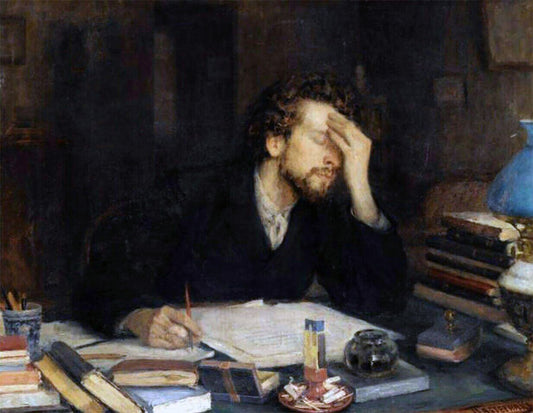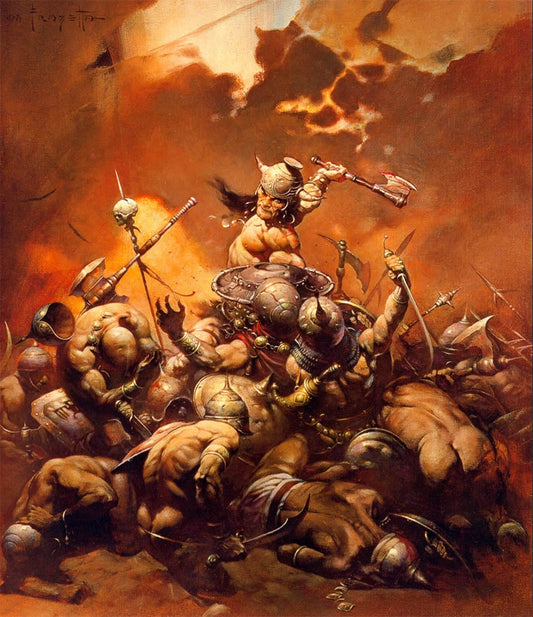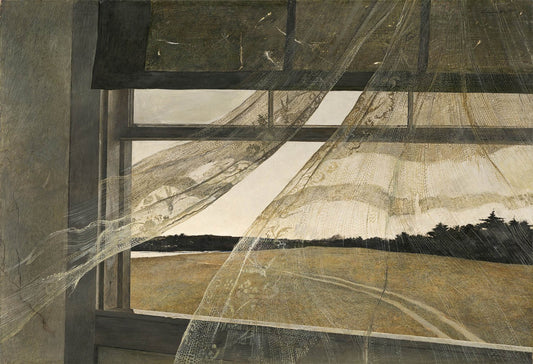Getting Intimate with Your Subject – A Look at Andrew Wyeth’s Artistic Approach
Andreas ClaußenShare
Ever find yourself staring at a blank canvas, wondering if it’s staring back at you? It’s a ridiculous thought, right? Yet, it’s not entirely untrue - after all, art is a conversation, and sometimes, it’s the subject that does all the talking. I’ve been mulling over Andrew Wyeth, the guy who could turn a patch of weeds into a masterclass in emotional depth. His life, his art, his almost obsessive connection to his subjects - it’s got me thinking: how close do you really need to get to your subject to paint something that feels... alive?
Andrew Wyeth wasn’t just some guy who painted old barns and cold-looking women. Born in 1917 in Chadds Ford, Pennsylvania, Wyeth had art in his blood - his father, N.C. Wyeth, was a rockstar illustrator back in the day. Andrew was the kid who absorbed everything from his father, but like any rebellious teen with an artistic streak, he decided to find his own path and take the whole "observe and paint" thing to another level. It’s like he zoomed in on life’s small moments and found entire universes within them. And honestly, it’s hard not to be a little jealous of his focus.
But here’s the thing: N.C. Wyeth, with all his larger-than-life illustrations of adventure and heroism, didn’t quite get what his son was up to. There’s this story - a classic father-son moment - where Andrew shows his dad a painting of a lone man working in the fields. N.C. takes a look and says, “Andrew, nice painting, but where’s the gun? Or the dog?” For N.C., every scene was an action shot waiting to happen, filled with drama and movement. But Andrew? He was all about the quiet moments, the pauses, the spaces in between. He didn’t need a gun or a dog to tell his story - the solitude, the stillness, that was the story. It’s like they were speaking different artistic languages, and while N.C. was all about the big bang, Andrew found his power in the whisper.

Wyeth had this almost eerie ability to capture the essence of his subjects with just a few colors - his palette was about as varied as a minimalist's wardrobe. He wasn’t showing off with flashy colors; he was digging deeper, peeling back layers. Take "Christina’s World," for example. It’s not just a painting of a woman in a field; it’s a visual biography of struggle, determination, and a silent plea to the universe. When you look at that painting, you don’t just see Christina - you feel her. Wyeth spent hours, days even, studying his subjects like they were mysteries he was meant to solve. And maybe that’s what made his work so compelling; he wasn’t just painting what he saw, but what he felt, heard, and imagined. The man was like a psychic with a paintbrush.

But let’s not sugarcoat it - Wyeth was controversial. Some critics thought he was too sentimental, too attached to a past that didn’t push the boundaries of modern art. “Sentimental,” they said, as if capturing the fading beauty of a dying leaf wasn’t enough. But maybe Wyeth was onto something. Maybe, just maybe, the world doesn’t need more boundaries pushed; maybe it needs more connection, more humanity - more of what Wyeth was giving us, even if we didn’t know we needed it.

Now, let’s get personal for a second - because isn’t that what Wyeth would do? If you’re an artist, or even just pretending to be one on the weekends, the takeaway here is blindingly simple: get close to your subject. And I don’t mean just physically close. I’m talking emotionally, spiritually, and every other “-ly” you can think of. Know your subject like you know the back of your hand - actually, scratch that. Know it better, because honestly, how often do you really look at the back of your hand?
Imagine this: you’re painting a tree. But not just any tree - this is your tree. The one you climbed as a kid, the one that held your first secret hiding spot. You notice the roughness of the bark, the way the light filters through the leaves at 3 p.m. in the middle of summer, the tiny insects that make this tree their home. Suddenly, it’s not just a tree. It’s a story, a memory, a living, breathing entity that has as much to say as you do. And that’s when the magic happens - that’s when you stop painting trees and start painting life.

Here’s a little secret: the more you know about your subject, the less you’ll care about what the critics say. You’ll be too busy diving into those subtle details - the ones that most people overlook but that make your work resonate on a deeper level. Like Wyeth noticing how the shadows change on a dilapidated fence as the day goes by. Or how the mood of a room shifts with the slightest change in light. You don’t get that kind of insight from a quick glance. You get it from obsession, from passion, from love. Yes, love. I said it. Because if you’re not in love with what you’re painting, what’s the point?

But enough of the sappy stuff. Let’s talk tactics. Keep a sketchbook. I know, I know - it’s the oldest advice in the book. But it works. Sketch everything - thoughts, doodles, random lines that make no sense. Write down what you see, what you feel. The world is full of subtle details just waiting to be captured, and sometimes, the best way to find them is to scribble them down in the margins of your life.

And if you’re feeling brave, experiment. Try different approaches, even if they make you uncomfortable. Paint from life, paint from memory, paint from dreams. Mix and match until you find what clicks. Wyeth wasn’t afraid to explore different techniques to get closer to his subjects, and neither should you be. He played with light and shadow like a kid with a new toy - no rules, just pure discovery.

In the end, the best way to create deeper, more meaningful art is to let your subject in. Let it consume you, haunt you, follow you around like a lost puppy until you’ve captured its essence on canvas. And who knows? Maybe one day, someone will stare at your painting and feel what you felt. And isn’t that what it’s all about?




